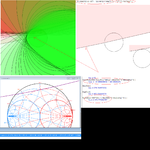Terminator3
Advanced Member level 3

While comparing my calculations of stability circles i compared it to Smith v3.10 program and found one problem:

i am using NE3210S01v1_2-18_2_10.S2P file as data source. Problems occur at frequency of 7.5GHz, where output stability circle (instable outside) overlaps reflection=1 circle in much bigger area in my case. I rechecked formulas with SpeqMath. And as other circles on input and output looks similar to Smith v3.10 program formulas must right. Also i rechecked my formulas with examples in few papers to find stability circle centers and radius. But then i noted that in Smith v3.10 S11 coefficient is written as S11=0.78, although in data file S11=0.699. So i changed this line in s2p file to check this idea:
then output stability circle in my calculations moved out of smith chart, and started to look more similar to Smith v3.10.
Does this mean that small variation in this parameters affects stability circle very much, and it is better to choose bigger stabilizing rezistor for example (bigger than value obtained by constant-resistance or conductance circles)?

i am using NE3210S01v1_2-18_2_10.S2P file as data source. Problems occur at frequency of 7.5GHz, where output stability circle (instable outside) overlaps reflection=1 circle in much bigger area in my case. I rechecked formulas with SpeqMath. And as other circles on input and output looks similar to Smith v3.10 program formulas must right. Also i rechecked my formulas with examples in few papers to find stability circle centers and radius. But then i noted that in Smith v3.10 S11 coefficient is written as S11=0.78, although in data file S11=0.699. So i changed this line in s2p file to check this idea:
Code:
! f S11 S21 S12 S22
! GHz MAG ANG MAG ANG MAG ANG MAG ANG
7.50 0.699 -82.7 4.170 85.3 0.065 36.6 0.423 -59.2
to
7.50 0.7 -82.7 4.170 85.3 0.060 36.6 0.42 -59.2Does this mean that small variation in this parameters affects stability circle very much, and it is better to choose bigger stabilizing rezistor for example (bigger than value obtained by constant-resistance or conductance circles)?
